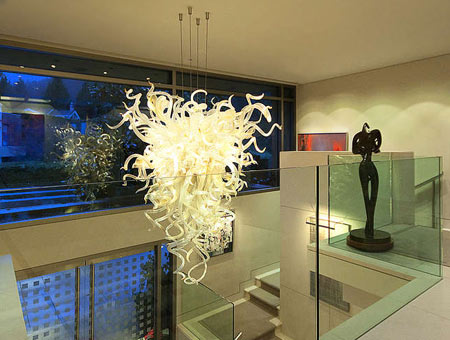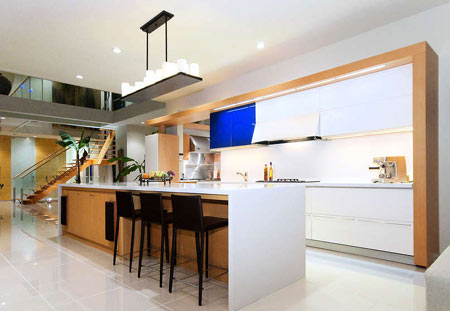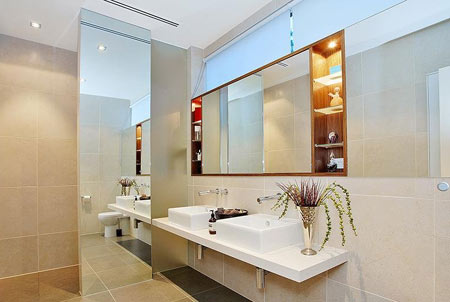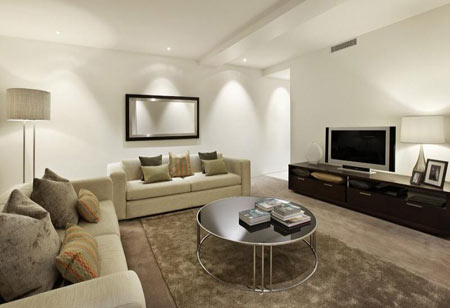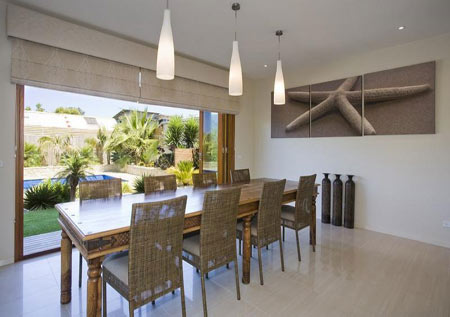Illuminate a home
Once considered to be strictly functional, lighting has evolved into a decorative element, contributing a great deal to ambiance and warmth. Without adequate lighting, even the most beautiful pieces of furniture may go unnoticed.
General lighting
General lighting is switch-operated and is used to illuminate a room. Ceiling fixtures installed in common rooms, hallways and bedrooms fall in that category. You can add a majestic touch to your main entrance hall by lighting it with a suspended candelabra-style fixture. You could even install one over the staircase leading to the second floor. Ceiling fans that include light fixtures are also popular in entrance halls and staircases.
Suspended chandelier-type fixtures or the more modest wall-mounted models installed in the living room can also provide adequate lighting with a touch of originality. Recessed fixtures are often used as the main source of lighting in kitchens, bathrooms and basements. Installed in sufficient numbers, they provide good lighting and prove to be practical in small rooms or in rooms with low ceilings.
Functional lighting
Functional fixtures must provide adequate lighting for a number of home activities. A fluorescent tube installed over a workbench will allow you to work at ease in a well-lit area. The kitchen island counter, the sewing room and that part of the bathroom located near the mirrors would most likely benefit from recessed or track lighting. Closets and wardrobes require no more than the traditional single-bulb fixture installed on the ceiling or over the door and operated by means of a switch or chain.
Accent or decorative lighting
Accent and decorative lighting fixtures are numerous and varied. Some are more practical than others. They are used to set off elements of decor or artifacts. Using different types of lighting in the same room gives the room a different ambiance and personality at the simple touch of a switch.
Shop around and you will find unusual lighting items such as lit animals or pedestal-mounted scenery topped off with a bulb and a patterned or fabric shade. Whether used as nightlights, bedside table lamps or for area lighting, these fixtures can be both decorative and useful. Likewise for pedestal lamps or candelabras that you will find in rustic, country, art deco or modern styles.
Lighting is becoming an increasingly important decorating element. For example, you can use recessed spotlights to illuminate art or other parts of the decor you wish to highlight. You can use anything from illuminated cornices to aquariums to create original lighting arrangements and personalize your decor. Or use a ceiling multidirectional recessed fixture to create shadow patterns on a wall.
Adequate lighting
Pleasant and effective lighting calls for a balance of direct and indirect sources of light.
Direct: This effect is obtained by pointing the light downward. Work surfaces and decorative elements such as art, plants and precious artifacts need direct lighting. Mural appliqués, work or read lamps and rail spotlight lighting are examples of direct lighting.
Indirect: Direct lighting must be combined with indirect sources of light that produce broader lighting such as, for example, candelabras, ceiling lamps and built-in lamps. Since the light is projected towards the ceiling, color will have an effect on the lighting intensity. On a white ceiling, the reflection will be stronger than on a ceiling painted in a darker colour.
Semi-direct: Semi-direct lighting allows you to create a particular ambiance. Secondary lamps, side-table lamps, etc., all lamps with shades that project 40% of their light towards the ceiling and 60% towards the floor.
Security directions
* Always disconnect power at the main source before engaging in the installation of lighting fixtures that require wiring.
* Use a test plug to ensure power has effectively been disconnected before working on wall plugs, switches or octagon boxes.
* Avoid touching halogen bulbs with the naked hand. Body oils tend to reduce their life expectancy.
* Turning fluorescent tubes on and off frequently will reduce their life expectancy.
How to save energy with lighting
There are many ways to save energy if you choose the right lighting. Bulbs and dimmers can save you money on your electrical bill if carefully chosen. The following tips and facts will help you make the bright decision.
* An incandescent bulb dimmed by just 10% requires 5% less electricity and lasts twice as long! A good dimmer is the right choice!
* A single, high-wattage bulb uses less electricity than several low-wattage bulbs.
* Halogen bulbs are the most energy efficient type of lighting you can buy. They are 25% brighter and last three times longer than incandescent bulbs. You save more energy with halogen fixtures with reflector backs because they seem to project brighter light.
* Fluorescent bulbs give brighter light and consume 60% less electricity than do incandescent bulbs. They also last 13 times longer.
* A 26 W compact fluorescent lamp gives a similar amount of light to a 75 W incandescent lamp, but consumes 60% less energy.
* When using recessed 2-3-tube fluorescent fixtures, you save about 70% energy.
You are sure to find what you need among the wide variety of fixtures available at your local Builders Warehouse, whether you are looking for decorative, accent, general or simply functional lighting.

